Related Research Articles

The horse is a domesticated, one-toed, hoofed mammal. It belongs to the taxonomic family Equidae and is one of two extant subspecies of Equus ferus. The horse has evolved over the past 45 to 55 million years from a small multi-toed creature, close to Eohippus, into the large, single-toed animal of today. Humans began domesticating horses around 4000 BCE, and their domestication is believed to have been widespread by 3000 BCE. Horses in the subspecies caballus are domesticated, although some domesticated populations live in the wild as feral horses. These feral populations are not true wild horses, which are horses that never have been domesticated. There is an extensive, specialized vocabulary used to describe equine-related concepts, covering everything from anatomy to life stages, size, colors, markings, breeds, locomotion, and behavior.

The yak, also known as the Tartary ox, grunting ox, or hairy cattle, is a species of long-haired domesticated cattle found throughout the Himalayan region of the Indian subcontinent, the Tibetan Plateau, Gilgit-Baltistan (Kashmir), Tajikistan and as far north as Mongolia and Siberia. It is descended from the wild yak.

Upper Mustang is an upper part of Mustang District, which is located in Nepal. The Upper Mustang was a restricted kingdom until 1992 which makes it one of the most preserved regions in the world, with a majority of the population still speaking traditional Tibetic languages. Tibetan culture has been preserved by the relative isolation of the region from the outside world. Life in Mustang revolves around tourism, animal husbandry, and trade.

The Konik or Polish Konik is a Polish breed of pony. There are semi-feral populations in some regions. They are usually mouse dun or striped dun in color.

The Eriskay Pony is a breed of pony from Scotland. It is generally grey in colour, and has a dense, waterproof coat that protects it in harsh weather. The breed developed in ancient times in the Hebrides of Scotland, and a small population remained pure and protected from crossbreeding by the remoteness of the islands. It is used for light draught work, as a mount for children, in many equestrian disciplines, and for driving.

The Exmoor Pony is a British breed of pony or small horse. It is one of the mountain and moorland pony breeds native to the British Isles, and so falls within the larger Celtic group of European ponies. It originates on, and is named for, the Exmoor area of moorland in north-eastern Devon and western Somerset, in south-west England, and is well adapted to the climate conditions and poor grazing of the moor. Some still live there in a near-feral state, but most are in private ownership.
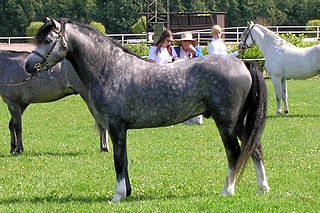
The Welsh Pony and Cob is a group of four closely-related horse breeds including both pony and cob types, which originated in Wales in the United Kingdom. The four sections within the breed society for the Welsh breeds are primarily distinguished by height, and also by variations in type: the smallest Welsh Mountain Pony ; the slightly taller but refined Welsh Pony of riding type popular as a children's show mount; the small but stocky Welsh Pony of Cob Type, popular for riding and competitive driving; and the tallest, the Welsh Cob, which can be ridden by adults. Welsh ponies and cobs in all sections are known for their good temperament, hardiness, and free-moving gaits.

The Marwari or Malani is a rare breed of horse from the Marwar region of Rajasthan, in north-west India. It is closely related to the Kathiawari breed of the Kathiawar peninsula of Gujarat, with which it shares an unusual inward-curving shape of the ears. It is found in all equine colours, including piebald and skewbald. It is a hardy riding horse; it may exhibit a natural ambling gait.
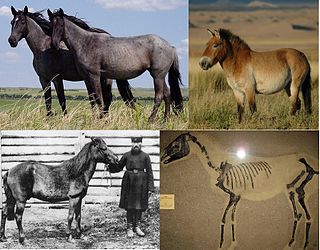
The wild horse is a species of the genus Equus, which includes as subspecies the modern domesticated horse as well as the endangered Przewalski's horse. The European wild horse, also known as the tarpan, that went extinct in the late 19th or early 20th century has previously been treated as the nominate subspecies of wild horse, Equus ferus ferus, but more recent studies have cast doubt on whether tarpans were truly wild or if they actually were feral horses or hybrids.

Nagqu is a prefecture-level city in the north of the Chinese autonomous region of Tibet. On May 7, 2018, the former Nagqu Prefecture was officially declared the sixth prefecture-level city in Tibet after Lhasa, Shigatse, Chamdo, Nyingchi and Shannan. The regional area, covering an area of 450,537 km2 (173,953 sq mi), is bordered by Bayingolin and Hotan Prefectures of Xinjiang to the north, Haixi, Yushu Prefectures of Qinghai and Chamdo to the east, Nyingchi, Lhasa and Shigatse to the south, Ngari Prefecture to the west. As of the 2010 census, it had a population of 462,381.
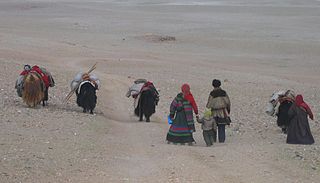
The Changtang is a part of the high altitude Tibetan Plateau in western and northern Tibet extending into the southern edges of Xinjiang as well as southeastern Ladakh, India, with vast highlands and giant lakes. From eastern Ladakh, the Changtang stretches approximately 1,600 kilometres (990 mi) east into Tibet as far as modern Qinghai. The Changtang is home to the Changpa, a nomadic Tibetan people. The two largest settlements within the Tibetan Changtang are Rutog Town the seat of Rutog County and Domar Township the seat of Shuanghu County.

The Falabella is an Argentine breed of small horse. It is among the smallest of horse breeds, with a height at the withers in the range 63–86 cm (25–34 in)..
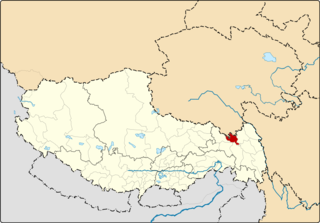
Riwoche is a county under the administration of the prefecture-level city of Chamdo in the Tibet Autonomous Region, China. The county lies in eastern Tibet and borders Qinghai province to the north.

The Tibetan pony is a horse breed originating in Tibet. Once thought to be simple hardy mountain ponies developed from Mongolian stock, recent research indicates that there may be up to six separate horse breeds native to Tibet.
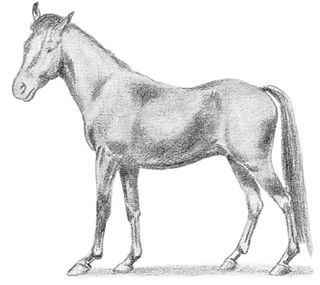
The Manipuri Pony is a traditional Indian breed of small horse or pony from Assam and Manipur in north-eastern India. It appears both in the history and the mythology of Manipur, and was used for warfare and polo. It is believed to have been the polo pony in use in Assam in the mid-nineteenth century when British tea planters first saw polo being played, and the height limits set for polo ponies were based on ponies of this breed. It was very numerous in the early twentieth century, but numbers have since fallen. A breed society was established in 1977, and a breed standard was drawn up by the Indigenous Horse Society of India in 2009.

Michel Georges Francois Peissel was a French ethnologist, explorer and author. He wrote twenty books mostly on his Himalayan and Tibetan expeditions. Peissel was an emeritus member of the Explorers Club and a Fellow of the Royal Geographical Society.

A pony is a type of small horse. Depending on the context, a pony may be a horse that is under a given height at the withers, or a small horse with a specific conformation and temperament. Compared to a larger horse, a pony may have a thicker coat, mane and tail, with proportionally shorter legs, a wider barrel, heavier bone, a thicker neck and a shorter, broader head. The word pony derives from the old French poulenet, meaning foal, a young, immature horse.
The Riwoche horse is a dun-colored, pony-sized horse indigenous to northeastern Tibet. It came to international attention in 1995, at which time its primitive appearance and small size led to speculation that it might be an evolutionary link between the prehistoric wild horse and the modern domestic horse. Subsequent analysis, however, demonstrated that it is genetically indistinguishable from modern horses.

Yushu is a horse breed originating from the Tibetan autonomous prefecture of Yushu in Tibet, administratively located in Qinghai, China. It is a local variety of the Tibetan pony. About its measurements, it is medium-sized and one of the few horse breeds that have the champagne gene. Its breeding was discouraged by Chinese authorities in the 1990s. Fit for the saddle, Yushu is adapted to its highland environment. It has been the subject of several studies on its genetic diversity and blood composition. The breed has become rare today, although it is not considered endangered by the Food and Agriculture Organization (FAO). It is honored every year at a major equestrian festival, which attracts thousands of spectators.
References
- 1 2 Peissel, Michel. "Reserve on the roof of the world" Geographical, April, 1999 accessed September 10, 2009
- ↑ Dam, Julie K.L., Bruce Crumley/Paris and Helen Gibson/London. "Ancient Hoofbeats: In Tibet, A Missing Link in Equine Evolution?" Time, November 27, 1995 Volume 146, No. 22. Accessed September 10, 2009
- 1 2 Lowry, Susan. "Explorer backs Tibetan dark horse in the history stakes." Fortean Times (reprinted) Archived 2016-03-03 at the Wayback Machine Accessed September 10, 2009
- 1 2 Peissel, Michel (2002). Tibet: the secret continent. Macmillan. p. 36. ISBN 9780312309534.
- Simons, Marlise. "A Stone-Age Horse Still Roams a Tibetan Plateau." New York Times, November 12, 1995
- Hilchey, Tim. "Purebred Horse Unknown to West Is Reported in Highlands of Tibet." New York Times, Tuesday, May 24, 1994
- Peissel, Michel (2002). Tibet: the secret continent. Macmillan. p. 36. ISBN 9780312309534.
- Peissel, Michel. "Reserve on the roof of the world" Geographical, April, 1999
- Hays, Jeffrey. "Tibetan Animals and Plants." Facts and Details 2008.
- Cannell, Harry. "Chámă Gŭdaò –Tibet and the Tea-Horse Road." Aurlaea, July 18, 2009